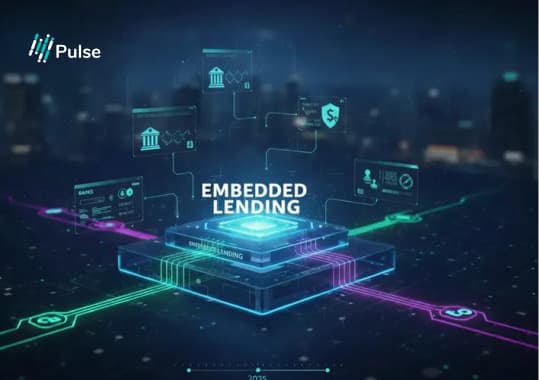Embedded finance has long been talked about as a disruptive force in finance. As we approach 2026, it has become a core driving force for UK players across retail, logistics, businesses and other niches. It has changed the way people access funding, allowing non-financial stakeholders to offer lending as a service. Whether it’s insurance, payments, lending, or investments, there is immense potential for growth on the horizon. This blog will discuss three key trends that deserve the attention of fintech leaders, banks, lenders, brokers, accountants, and other stakeholders.
Vertical-specialised banking services are becoming table stakes
While the initial wave of embedded finance centred on consumer-facing models like point-of-sale credit or “buy now, pay later” (BNPL), we are now entering a phase where platform players in non-financial verticals are embedding tailored banking services that are industry-specific.
In the UK, the interplay of open banking regulation (via the Open Banking Implementation Entity and PSD2) alongside mature API landscapes gives non-banks a viable route to integrate account services, payment initiation services (PIS) and lending, without building the entire infrastructure.
Key Dynamics in 2026:
- Platforms in sectors such as mobility (e-hailing, rental), logistics, and retail loyalty ecosystems will embed full banking services such as accounts, payments, and lending rather than simply offering payments.
- Providers will demand more from embedded-finance providers. In the UK, research shows 80 % of major brands have seen conversion, basket-size or loyalty increase via embedded finance, but few believe their current provider offers “customer excellence” at scale.
- For banks and lenders, this means they risk being relegated to “utility infrastructure” unless they evolve into embedded-finance enablers or become platform partners themselves.
For UK strategists, this means: if you are in a non-financial vertical, ask where banking and lending services plug directly into your customer journey, and not just as an add-on. If you are a financial firm, ask yourself how you support those verticals in a way that preserves your regulatory compliance, brand trust, and scalability.
B2B Embedded Finance Will Become a Battleground
Embedded finance is usually talked about in the context of consumer lending or payments. But the business-to-business (B2B) domain is where real scalability and complexity lie for 2026. Studies suggest that stakeholders serving small businesses, procurement flows, and SME ecosystems will embed finance solutions such as invoice financing, working-capital lines, credit lines or revenue-based financing.
- SME lending remains an underserved market compared to consumer credit. Integrating finance into platforms that businesses already use, such as accounting software, procurement networks, supply-chain marketplaces, or business intelligence dashboards, helps make the finance contextual, almost instantaneous and sticky.
- UK market reports already show increased customer-expectation levels. Brands that embed finance say they experience higher support burdens and require scalability.
- In 2026, we will start to see a major push from vertical SaaS. For example, construction, logistics, and hospitality will embed financing tools or solutions as default features rather than optional add-ons.
For the UK, it would be critical to prioritise partnerships between digital platforms and finance solutions. Think about automated underwriting models that use platform data (cash-flow, transaction history, etc.) rather than traditional credit metrics. Stakeholders should ensure they have the regulatory readiness and the tech-stack to scale operations.
AI-Enabled Personalisation and ‘Contextual Lending”
The third trend: finance embedded into journeys, powered by AI and rich context. This isn’t simply offering credit at the point of sale but offering the right financial product at the right time, based on behaviour, platform activity and real-time data. Analytics, machine learning and alternative data sources make this possible.
- With the staggering growth of embedded lending and lending-as-a-service, AI, real-time data, and machine learning help make contextual lending possible and scalable.
- Example: Pulse’s Unified Lending Interface (ULI) empowers banks, lenders, brokers, aggregators and the businesses they serve with a suite of solutions designed to automate, expedite, and streamline the lending process.
Pulse’s Loan Origination System (LOS) helps digitise and automate the loan application process, reducing it to under 3 minutes. Pulse’s Einstein aiDeal automates underwriting, with customisable criteria, being able to auto-decision 95% of deals in under 45 seconds. Once the loan amount is disbursed, Pulse’s Loan Management System (LMS) helps users track repayments, defaults and delays, with automated reminders. To learn more about Pulse, contact us today.
The result? Banks can effortlessly scale operations and revenue with automated underwriting, near-instant decisions and embedded compliance. Lenders and brokers can abandon traditional, tedious application processes and leverage Pulse LOS for a quick, seamless process. Businesses can access funds faster with a robust and convenient user journey. All of this can be embedded into existing systems like accounting software or business intelligence dashboards, where the ideal lending product pops up depending upon the client’s needs: contextual lending in practice.
Therefore, in 2026, the winners in embedded finance will not be those who simply integrate financial services, but those who orchestrate them intelligently, make them invisible in the user journey, and still comply with UK-specific regulatory and data-governance frameworks.
Conclusion
Embedded finance and its impending success depend largely on scalability, speed, and accuracy. The trends define the scenario of 2026. Companies that treat embedded finance as a core strategic layer within existing systems rather than a mere add-on will be able to offer genuine value, build deeper customer relationships and create new revenue streams. Meanwhile, fintech ecosystem players should shift from showcasing “we can embed credit” to being trusted, scalable, compliant partners in embedded journeys, with Pulse ULI being an excellent example.
Related Blogs


